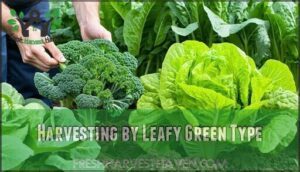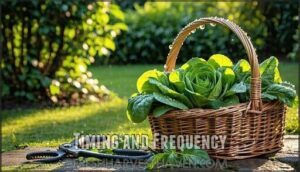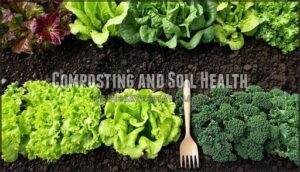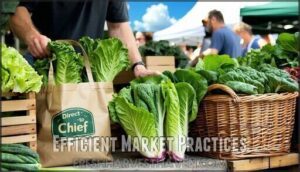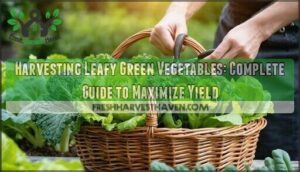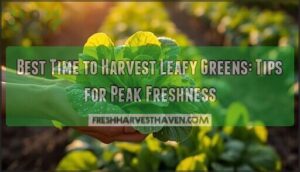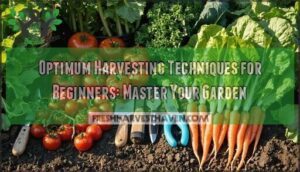This site is supported by our readers. We may earn a commission, at no cost to you, if you purchase through links.
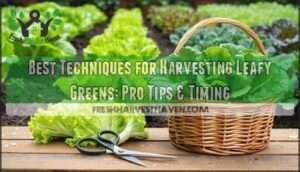
Use sharp, clean scissors or knives to make precise cuts that encourage regrowth. Harvest in cool morning hours when leaves are crisp and hydrated.
For lettuce and spinach, cut outer leaves first, leaving the center to continue growing. With kale and chard, select mature outer leaves while keeping younger inner ones intact.
This "cut-and-come-again" method extends your harvest season substantially. Always handle freshly cut greens gently to prevent bruising and wash immediately in cold water.
The real magic happens when you understand each plant’s unique growth patterns and recovery needs.
Table Of Contents
- Key Takeaways
- Harvesting Leafy Greens Basics
- Best Harvesting Techniques
- Harvesting Leafy Greens Safely
- Sustainable Harvesting Practices
- Maximizing Leafy Green Yields
- Frequently Asked Questions (FAQs)
- What is the best way to harvest greens?
- What is the most commonly practiced method of harvesting vegetables?
- When to harvest green leaves?
- How to harvest kale and spinach?
- How do you harvest Greens in a garden?
- How long does it take to harvest leafy greens?
- What is a leafy green harvest?
- What greens can I Harvest with a cut and come again method?
- How frequently should I harvest my greens?
- How do you harvest vegetables?
- Conclusion
Key Takeaways
- Use sharp, clean tools and harvest in cool morning hours – You’ll get the crispest greens by cutting with sanitized scissors or knives when leaves are hydrated and temperatures are low.
- Apply the cut-and-come-again method for continuous harvests – You should cut outer leaves first while leaving the growing center intact, allowing plants to regenerate for multiple harvests throughout the season.
- Handle freshly cut greens gently and wash immediately – You’ll prevent bruising and maintain quality by avoiding rough handling and washing your harvest in cold water right after cutting.
- Never harvest more than one-third of any plant at once – You’ll ensure healthy regrowth and avoid plant stress by taking only mature outer leaves and leaving enough foliage for the plant to continue photosynthesis.
Harvesting Leafy Greens Basics
Before you start harvesting leafy greens, you’ll need to understand the different types and their unique characteristics.
Each variety—from tender spinach and lettuce to hardy kale and Swiss chard—has specific nutritional profiles and growth patterns that affect when and how you should harvest them, considering their unique characteristics.
Types of Leafy Greens
Understanding leafy greens reveals harvesting success for your garden. Each variety brings unique nutrient differences and culinary uses to your table.
Here are three essential categories:
- Cool-season champions – Kale, spinach, and lettuce varieties thrive in cooler weather
- Specialty harvests – Micro-greens and beet greens offer gourmet options
- Heat-tolerant options – Swiss chard and collards handle warmer conditions
Master these suitable greens for harvest and you’ll enjoy diverse flavors year-round through proper harvesting techniques.
Growth Characteristics
Each leafy green variety follows distinct growth stages with varying maturation rates that affect your harvesting success.
While spinach races through leaf development in just 30-45 days, kale takes its sweet time at 55-75 days, developing thicker leaf texture.
Understanding these growth characteristics helps you master cut and come again harvesting techniques, promoting plant regeneration for continuous growth throughout the season.
For best results, consider the prime harvest window during the early morning.
Nutritional Profiles
Your harvest contains nature’s most potent nutritional powerhouses. Fresh-picked leafy greens varieties deliver peak vitamin content and mineral benefits that store-bought can’t match.
Each type offers distinct nutritional content:
- Kale: Vitamin K champion with more calcium per serving than milk
- Spinach: Iron-rich with folate that supports healthy blood cell production
- Swiss Chard: Colorful stems packed with vitamins A and C
- Collard Greens: High-fiber nutrientrich vegetables with impressive magnesium levels
These low calorie counts don’t mean low nutrition. Their antioxidant properties fight inflammation while maintaining excellent macronutrient balance. Proper harvest timing preserves these vitamins and minerals at their nutritional peak.
Best Harvesting Techniques
You’ll harvest the highest quality leafy greens by using the right tools and techniques for each variety.
Proper timing and cutting methods guarantee continuous production while keeping your plants healthy and productive.
Cutting Tools and Methods
Right tools make all the difference when harvesting leafy greens. Sharp scissors work perfectly for delicate lettuce and spinach, while harvest shears handle tougher kale stems. Your cutting techniques should create clean cuts that heal quickly and encourage regrowth.
| Tool Type | Best For | Key Feature |
|---|---|---|
| Garden scissors | Tender greens, herbs | Precision cutting |
| Leaf clippers | Medium stems, chard | Comfortable grip |
| Pruning tools | Thick kale, collards | Heavy-duty blades |
Keep your sharp tools spotless between plants. Dirty blades spread disease faster than gossip at a garden club meeting. The cut-and-come-again method works best when you slice 1-2 inches above soil level. This harvesting technique lets plants bounce back stronger for multiple harvests throughout the season. Using proper garden scissors care is essential for maintaining healthy plants and preventing the spread of disease.
Harvesting by Leafy Green Type
Different greens require specialized approaches for maximum harvest success. Each variety responds best to specific techniques that maximize yield and encourage regrowth.
Kale harvesting works from the bottom up—remove mature outer leaves while preserving the crown. Spinach picking follows the leaf-by-leaf method, taking older leaves first. Swiss chard allows flexibility with both individual leaf removal or whole plant cutting. Lettuce varieties thrive with cut-and-come-again harvesting, while collard greens benefit from lower leaf removal. Beet greens can be harvested at any stage, from tender thinnings to mature leaves.
Micro greens require gentle handling when leaves are tiny and delicate.
- Harvesting kale: Never take more than one-third of leaves at once
- Cutting spinach: Use sharp scissors 1-2 inches above soil level
- Harvesting leafy greens: Pick during cool morning hours for crispness
- Harvesting collard greens: Focus on bottom leaves to maintain plant energy
- Harvesting swiss chard: Cut stems cleanly to prevent disease entry
For maximum results, understanding lettuce harvest times is vital for maximizing yields.
Timing and Frequency
Perfect harvest timing transforms your garden into a continuous production powerhouse.
Transform timing into your garden’s greatest ally—harvest smart, harvest often.
Harvest in early morning when leaves are crisp and hydrated for peak quality.
Schedule harvest intervals every 3-4 weeks during growth stages, allowing proper leaf regrowth between cuts.
Continuous harvesting encourages new development while crop rotation maintains soil health.
- Your taste buds will celebrate the superior flavor of morning-picked greens
- Your garden will reward you with extended harvests through proper timing
- Your family will notice the dramatic difference in freshness and nutrition
Harvesting Leafy Greens Safely
You can’t afford to skip safety protocols when harvesting leafy greens – contaminated produce puts both you and consumers at serious risk.
Proper handling, storage techniques, and worker hygiene create the foundation for delivering clean, fresh greens that won’t cause foodborne illness.
Handling and Storage Practices
Once you’ve harvested your greens, proper postharvest handling becomes your secret weapon.
Start with gentle washing techniques using cold water, then dry thoroughly to prevent decay.
Store at 32-36°F with humidity control at 90-95% using breathable packaging solutions.
Cooling methods like refrigeration immediately after harvest maintain crispness.
Keep greens away from ethylene producers like apples—they’ll turn your fresh harvest into compost faster than you’d expect.
To maximize yield and quality, understanding harvesting techniques is vital for maintaining healthy plants and promoting regrowth.
Preventing Contamination and Spoilage
Smart contamination prevention keeps your leafy greens fresh and safe. Water Testing guarantees clean irrigation, while Crop Sanitation starts in the field with proper Harvest Hygiene practices.
Clean tools, clean hands, clean harvest—contamination stops before it starts.
- Use sanitized cutting tools and clean containers for postharvest handling
- Test water sources regularly to prevent Soil Contamination
- Wash hands thoroughly before touching greens
- Keep harvested crops away from contaminated surfaces
- Follow Storage Safety protocols with proper temperatures and humidity
Clean washing leafy greens techniques and contamination prevention protect your harvest’s quality.
Worker Hygiene and Safety
Once you’ve addressed contamination risks, worker hygiene becomes your next line of defense for food safety.
Proper handwashing with soap for 20 seconds prevents 70% of E. coli contamination—that’s like having an invisible shield for your greens.
Personal protective gear including gloves and clean aprons cuts cross contamination by 80%.
Don’t forget equipment sanitizing between uses, which slashes surface pathogens by 90%.
Worker training in native languages boosts compliance by 33%, making your harvest operation both safer and more efficient for everyone involved.
Sustainable Harvesting Practices
You’ll build a healthier garden and planet when you harvest leafy greens using sustainable methods that protect soil and reduce waste.
Smart practices like composting, crop rotation, and efficient harvesting create a cycle that keeps your plants productive while supporting long-term environmental health.
Organic Fertilizers and Crop Rotation
Three things set your leafy greens harvest up for success: smart Crop Rotation, rich Organic Matter, and the right Fertilizer Types. If you want robust soil health, skip the chemical shortcuts and go organic.
Try these tips for sustainable harvesting and regenerative farming:
- Bone meal and fish emulsion add targeted nutrients, minus the harsh stuff.
- Coffee grounds boost acidity, perfect for greens that love a tangy soil.
- Alfalfa meal releases nitrogen slowly, so you won’t scorch your leaves.
- Worm castings bring beneficial microbes, keeping soil lively.
Rotating crops keeps pests guessing and nutrients flowing. With organic gardening, your soil thrives, and your greens stay vibrant. Using organic fertilizer options can enhance soil quality and support long-term crop health.
Composting and Soil Health
Healthy soil serves as the foundation for thriving leafy greens, and composting transforms your garden waste into liquid gold.
You’ll build soil structure while boosting nutrient retention through strategic composting practices.
Start with Soil Testing to establish baseline pH and nutrient levels—this guides your composting strategy.
Creating Compost Tea from finished compost provides immediate nutrition while supporting Microbe Management.
Simply steep compost in water for 24-48 hours, then apply weekly during growing season.
This liquid fertilizer feeds both plants and beneficial soil organisms.
Consider these sustainable practices for ideal soil health:
- Plant Green Manure crops like crimson clover between harvests to fix nitrogen naturally
- Layer brown and green materials in 3:1 ratios for balanced decomposition
- Turn compost piles bi-weekly to maintain proper aeration and temperature
Your composting efforts directly impact garden nutrition and create sustainable practices that reduce waste while building long-term soil fertility for continuous leafy green production.
Efficient Market Practices
Building healthy soil with compost sets the foundation, but your market practices determine profitability.
Strategic logistics management transforms quality harvests into consistent revenue streams.
Harvest optimization starts with timing your cuts to match market trends.
You’ll capture premium prices by scheduling pickups during peak demand periods, when restaurants need fresh inventory.
Supply chain efficiency matters—direct-to-chef relationships bypass distributors, increasing your margins by 21%.
Crop monitoring technology helps predict ideal harvest windows, reducing waste by 23%.
Your postharvest handling procedures should include immediate cooling and moisture control to extend shelf life.
Understanding optimum harvesting techniques is vital for maximizing yield and quality.
Food safety considerations require clean handling equipment and proper storage temperatures.
When harvesting leafy greens, maintain cold chain logistics to preserve crispness.
These harvesting techniques combined with smart market positioning create sustainable profits while building customer loyalty through consistent quality delivery.
Maximizing Leafy Green Yields
You’ll achieve better harvests when you understand how to pick greens without killing the plant. Strategic timing and proper techniques can triple your yield compared to one-time harvesting methods.
Avoiding Overharvesting and Plant Damage
Smart gardeners know that overharvesting kills productivity faster than poor weather. Harvesting techniques require finesse—think surgeon, not lumberjack.
Plant damage from aggressive cutting stunts leafy greens permanently. Your harvest timing determines whether plants bounce back or give up entirely.
Master these damage control principles for sustainable yields:
- Never take more than one-third of any plant’s leaf selection in a single harvest
- Use sharp, clean tools for precise cuts that heal quickly without infection
- Target outer leaves first—this plant handling method protects the growing crown
Regrowth techniques depend on avoiding damage to the plant’s energy-producing core. Gentle harvesting today means abundant greens tomorrow. Effective leafy green tools are essential for maximizing leafy green yields and minimizing plant damage.
Promoting Continued Growth and Regeneration
Cut-and-come-again harvesting maximizes your garden’s potential when done right. Regrowth techniques start with proper leaf pruning – snip outer leaves one inch above the soil, leaving the crown untouched. This plant care approach triggers new growth within days.
Regeneration methods depend on understanding growth stages. Young plants need lighter harvests, while mature ones handle heavier cutting.
Here’s your harvest schedule:
| Plant Type | Harvest Frequency | Regrowth Time |
|---|---|---|
| Lettuce | Every 2-3 weeks | 10-14 days |
| Kale | Weekly pickings | 7-10 days |
| Spinach | Every 10 days | 5-7 days |
| Swiss Chard | Bi-weekly | 14-21 days |
| Arugula | Every 2 weeks | 7-14 days |
Effective soil health management is vital for maximizing yields, and techniques like organic farming practices can substantially improve crop quality.
Extending harvest success requires consistent moisture and monthly feeding. Never remove more than half the leaves – you’ll stress plants and reduce future yields. With proper continuous harvests, expect three to four cuttings per season.
Weather Considerations and Adaptations
Weather’s climate impact transforms your harvest strategy year-round.
Monitor frost predictions 5-7 days ahead—harvesting before overnight freezes prevents water-soaked, translucent leaves in cold-sensitive varieties like lettuce.
For frost protection, floating row covers extend harvest by 30-40% less weather-related loss.
Heat tolerance requires early morning picks before 8 AM when temperatures stay below 85°F.
Shade management prevents bolting during heatwaves above 27°C, while irrigation systems maintain consistent moisture without waterlogged foliage.
Season extension techniques maximize yields:
- Mobile shade structures keep leaf temperatures 8°C cooler during summer harvests
Staggered planting creates harvest buffers, reducing total crop loss by 25% during unpredictable weather.
Sharp, sanitized tools prevent pathogen spread during wet periods, while breathable harvest containers decrease condensation by 20% in humid conditions.
Frequently Asked Questions (FAQs)
What is the best way to harvest greens?
Like a barber giving a perfect trim, you’ll harvest greens by cutting outer leaves with sharp scissors one inch above soil,
leaving inner growth intact for continuous production throughout the season.
What is the most commonly practiced method of harvesting vegetables?
You’ll typically harvest vegetables using the "cut and come again" method, snipping outer leaves with sharp scissors about one inch above soil level, allowing plants to regrow for continuous harvests.
When to harvest green leaves?
You’ll know it’s time when your greens whisper "pick me" – harvest them early morning or evening when they’re cool and crisp for peak freshness.
How to harvest kale and spinach?
Cut mature kale leaves from outside edges, leaving center growth point intact.
For spinach, snip individual leaves or cut entire plant one inch above soil.
Use sharp scissors during cool morning hours for best quality.
How do you harvest Greens in a garden?
Harvest leafy greens early morning when cool using sharp scissors.
Cut outer leaves first, leaving inner ones to regrow.
Snip one inch above soil level for continuous harvests every 3-4 weeks throughout the growing season.
How long does it take to harvest leafy greens?
Like a farmer’s dawn ritual, you’ll harvest most leafy greens in just 30-45 days from seed.
Baby greens are ready in 2-3 weeks, while mature leaves take 6-8 weeks to fully develop.
What is a leafy green harvest?
A leafy green harvest involves cutting or picking edible leaves from plants like lettuce, spinach, and kale.
You’ll snip outer leaves first, leaving inner growth intact for continuous production throughout the season.
What greens can I Harvest with a cut and come again method?
Like a garden’s renewable treasure chest, you can harvest kale, lettuce, spinach, Swiss chard, arugula, Asian greens, mustard greens, and collard greens using cut-and-come-again methods for continuous harvests.
How frequently should I harvest my greens?
You’ll want to harvest your greens every 3-4 weeks once they’re established. Pick the outer leaves when they’re 4-6 inches long, leaving the center to keep growing.
How do you harvest vegetables?
Sharp tools are your best friend – use clean scissors or knives to cut outer leaves first, leaving the center intact. Harvest in cool morning hours for crispest results.
Conclusion
Though you might think harvesting requires complex equipment, the best techniques for harvesting leafy greens actually rely on simple tools and timing.
Sharp scissors, clean cuts, and early morning harvests create the foundation for success.
Remember to harvest outer leaves first, handle gently, and wash immediately.
With proper technique, you’ll enjoy continuous harvests throughout the growing season.
These methods transform your garden into a reliable source of fresh, nutritious greens for your kitchen table.
- https://daitool.com/blogs/daitool-blog/how-to-harvest-lettuce-everything-you-need-to-know
- https://brightlanegardens.com/edible-garden/vegetable-garden/guide-to-harvesting-lettuce/
- https://plantura.garden/uk/vegetables/lettuce/how-to-harvest-lettuce
- https://www.gardenary.com/blog/how-to-harvest-lettuce-to-increase-production
- https://www.youtube.com/watch?v=I8za-fxJiS8


